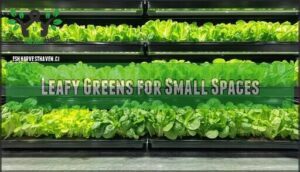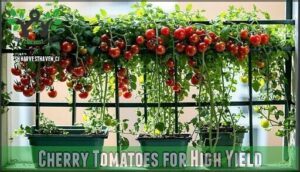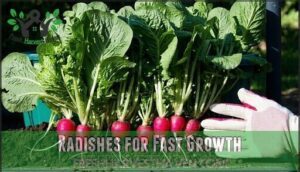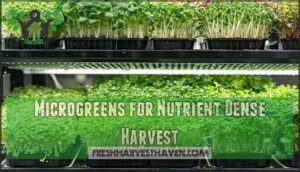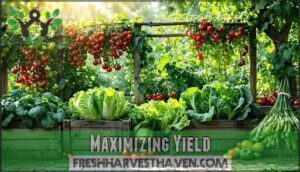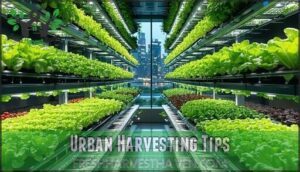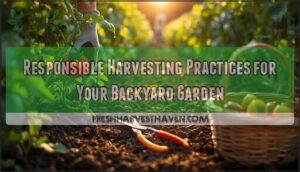This site is supported by our readers. We may earn a commission, at no cost to you, if you purchase through links.
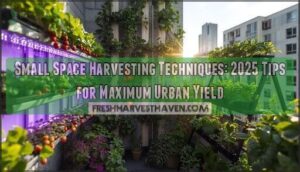
Vertical gardening systems like wall gardens and stacked planters increase your growing area by 300%, while hydroponic towers fit 24-36 plants in just 2-3 square feet.
Aeroponic systems deliver 45-75% higher yields than traditional methods using 98% less water through fine mist delivery.
LED grow lights boost yields by 40-95% with customizable spectra for indoor growing.
These techniques let you achieve up to 30 plants per square meter, turning any balcony or backyard corner into a high-yield harvest zone that outperforms conventional farming methods.
Table Of Contents
- Key Takeaways
- Small Space Farming
- Harvesting Techniques
- Space Saving Crops
- Maximizing Yield
- Urban Harvesting Tips
- Frequently Asked Questions (FAQs)
- How to grow the most food in a small space?
- What is the most common mistake of first time gardeners?
- What vegetables take up the least amount of space?
- How to farm in a small space?
- How much initial investment is needed?
- What tools are essential for beginners?
- How do pests affect small harvests?
- Can apartments handle weight of systems?
- Whats the learning curve for automation?
- How to store harvested produce without refrigeration space?
- Conclusion
Key Takeaways
- Maximize growing area through vertical systems – You’ll increase your planting capacity by 300% using wall gardens, stacked planters, and hydroponic towers that fit 24-36 plants in just 2-3 square feet.
- Choose high-yield, space-efficient crops – You can achieve continuous harvests by selecting fast-growing varieties like microgreens (7-14 days), cherry tomatoes (200+ fruits per plant), and leafy greens that regrow after cutting.
- Implement advanced growing technologies – You’ll boost yields by 40-95% using LED grow lights, aeroponic systems that deliver 45-75% higher yields with 98% less water, and automated hydroponic setups.
- Master timing and succession planting – You can maintain year-round production by harvesting at peak ripeness, rotating crops every 2-3 weeks, and using companion planting techniques that naturally control pests while optimizing soil health.
Small Space Farming
You’ll transform any cramped urban space into a productive food source using four proven vertical growing methods. These systems increase your growing capacity by 300% while requiring minimal floor space.
Vertical Gardening Techniques
Against bare walls, Wall Gardens and Living Walls transform dead space into productive growing zones.
Stacked Planters multiply your growing area by 300%, while Hanging Baskets capture overhead potential.
Vertical Supports like trellises guide climbing plants upward, freeing ground space for other crops.
These vertical gardening systems deliver up to 30 plants per square meter, making small space gardening incredibly efficient for urban farming methods.
By utilizing vertical gardening techniques, gardeners can maximize their harvest in limited spaces.
Container Gardening Methods
Breaking free from cramped quarters, container gardening transforms any urban nook into a productive powerhouse. You’ll maximize harvests by mastering three core principles that turn small spaces into green goldmines.
Essential Container Gardening Methods:
- Smart Container Selection – Choose self-watering containers with proper drainage holes, matching container size to root system requirements for ideal plant development and yield maximization.
- Strategic Potting Mix Optimization – Blend lightweight, nutrient-rich potting mixes with perlite for drainage, ensuring proper fertilization needs are met through slow-release granules integrated throughout growing medium.
- Efficient Watering Systems – Implement drip irrigation systems or moisture meters for precise watering techniques, while utilizing companion planting and organic pest control methods to maintain healthy container ecosystems.
Space optimization thrives when you select plastic containers that retain moisture effectively, reducing watering frequency. Your garden layout becomes a compact gardening masterpiece through strategic balcony gardening techniques that squeeze maximum productivity from minimal square footage.
Effective container gardening relies on understanding container garden principles to create thriving urban oases.
Hydroponic Systems for Small Spaces
Hydroponic tower-gardens let you transform cramped apartments into productive growing powerhouses. You’ll maximize vertical space with compact systems supporting 20-30% higher yields than traditional methods.
Transform cramped apartments into vertical farming powerhouses with hydroponic towers delivering 20-30% higher yields
| System Type | Plant Capacity | Space Required |
|---|---|---|
| Tabletop Units | 3-6 plants | 1-2 sq ft |
| Vertical Towers | 24-36 plants | 2-3 sq ft |
| Wall Systems | 12-24 plants | Wall-mounted |
Your hydroponic systems eliminate soil while delivering precise nutrient management through automated feeding cycles. Water recycling reduces usage by 90%, making indoor farming incredibly efficient. System automation handles pH monitoring and lighting schedules, freeing you from daily maintenance tasks.
Space optimization through vertical gardening multiplies your growing area without expanding outward. Container gardening enthusiasts find hydroponic crops like lettuce and herbs harvest every 28 days, creating continuous production cycles that traditional small space harvesting simply can’t match. By utilizing hydroponic systems, urban gardeners can enjoy increased crop yields and improved plant health.
Aeroponic Farming for Maximum Yield
Since aeroponic systems suspend roots in air and deliver nutrients through fine mist, you’ll achieve 45-75% higher yields while using 98% less water than traditional methods.
These hydroponic systems excel in indoor farming environments where space is premium.
Advanced nutrient delivery guarantees maximum root health through precise monitoring.
Water efficiency remains unmatched in vertical gardening setups.
Regular system sterilization prevents contamination, making microgreens harvesting remarkably productive in urban spaces.
Harvesting Techniques
Perfect timing turns ordinary harvests into maximum yields.
Smart timing transforms decent harvests into exceptional ones – harvest when plants peak, not when calendars dictate
You’ll harvest at peak ripeness when you master visual cues, systematic collection schedules, and gentle handling techniques that preserve nutritional value and extend storage life.
Key harvesting techniques for small space gardening:
- Gentle Harvest Methods: Use clean scissors above leaf nodes to encourage regrowth techniques while protecting plant roots
- Crop Timing Mastery: Monitor harvest cues like color changes and firmness rather than calendar dates for ideal flavor
- Selective Collection: Pick mature specimens while leaving developing ones, extending your harvest window substantially
- Microgreens Harvesting: Cut at soil level when first true leaves appear, typically 7-14 days after germination
- Yield Optimization: Harvest regularly in small amounts to maintain continuous production and prevent plant stress
Small space harvesting differs from commercial operations—you can pick at perfect ripeness since you’re not shipping across distances.
This backyard harvesting advantage means superior flavor and nutrition retention in every bite you collect.
Space Saving Crops
You’ll maximize your urban harvest by selecting crops that deliver exceptional yields in minimal square footage.
Smart crop choices like fast-growing leafy greens, compact cherry tomatoes, quick-cycle radishes, and nutrient-dense microgreens can transform even the smallest growing spaces into productive food sources.
Leafy Greens for Small Spaces
Your urban greens become unstoppable powerhouses when you master space saving techniques through vertical farm setups and windowsill gardening.
Leafy crop varieties like compact lettuce and baby spinach deliver continuous green harvest yields in container gardening systems.
Choose dwarf cultivars for maximum small space harvesting efficiency—you’ll get fresh urban greens every two weeks with proper compact gardening methods.
Understanding vertical farm systems is essential for optimizing your urban garden’s productivity.
Cherry Tomatoes for High Yield
Transform your cherry tomatoes into productivity powerhouses through strategic cultivation methods. You’ll achieve continuous harvests while maximizing every square foot of growing space.
Cherry varieties like ‘Sweet 100’ and ‘Surefire Red’ deliver exceptional yields in containers as small as 5 gallons. These high yield varieties produce 200+ tomatoes per plant when properly managed through intensive farming techniques.
- Tomato training: Install 6-foot stakes or cages to support vertical growth and prevent sprawling
- Tomato pruning: Remove suckers weekly to channel energy into fruit production rather than excess foliage
- Soil conditioning: Maintain consistent moisture with self-watering containers to prevent blossom end rot
Container gardening allows you to control growing conditions precisely. Start with balanced fertilizer during early growth, then switch to phosphorus-heavy formulations when flowers appear. Small space harvesting becomes effortless when you position containers for ideal sunlight exposure and easy access.
High yield tips include harvesting frequently to encourage continued production throughout the season.
Radishes for Fast Growth
Radishes rocket through their growth cycle faster than any other root crop you’ll grow.
These fast harvest champions germinate in 3-5 days and reach maturity in just 20-30 days, perfect for intensive farming cycles.
Cherry Belle and French Breakfast radish varieties excel in container gardening setups with only 4-inch soil depth requirements.
Their rapid growth rates and compact root development make succession planting every two weeks a breeze in your small space gardening operation.
Microgreens for Nutrient Dense Harvest
While radishes deliver quick turnarounds, microgreens pack maximum nutrient boost into minimal space.
These leafy greens contain up to 40 times more vitamins than mature plants, making them perfect for small-space gardening.
Your seed selection determines flavor profiles and nutritional density.
Harvest timing at 7-14 days guarantees peak nutrition using proper grow light setups.
Effective vertical gardening techniques can also enhance microgreen production in small spaces.
- Broccoli microgreens provide 100% daily vitamin K needs per serving
- Container gardening with shallow trays maximizes growing surface area
- LED grow lights support 200+ plants using just 10 watts
- Weekly harvesting techniques enable continuous production cycles year-round
Maximizing Yield
You’ll achieve maximum yield in small spaces by implementing strategic crop rotation, companion planting, and precise pruning techniques that work together to optimize every square inch.
These proven methods can triple your harvest potential while maintaining healthy soil and natural pest control systems.
Crop Rotation for Soil Health
Since soil testing reveals what your plants need, you can plan effective farm rotation that prevents nutrient depletion.
Rotating plant families—nightshades, brassicas, legumes—breaks disease cycles while supporting soil renewal through natural composting processes.
This succession planting approach maintains soil management in small-space gardening by cycling organic matter efficiently.
Strategic crop rotation prevents pest buildup and enhances soil structure for sustained urban harvests.
By implementing a well-planned crop rotation schedule, gardeners can optimize their soil health and maximize yields, which is crucial for sustained urban harvests and effective farm rotation.
Companion Planting for Pest Control
Building from crop rotation principles, companion planting creates natural pest deterrents through strategic plant pairing.
This biological controls approach reduces pest populations by up to 60% compared to single-crop methods, transforming your small space into a self-protecting ecosystem.
Four proven companion combinations for natural pest control:
- Basil + Tomatoes – Repels hornworms and aphids while boosting flavor through natural barriers
- Marigolds + Root Vegetables – Deters nematodes and attracts beneficial predators like ladybugs
- Nasturtiums as Trap Crops – Lure cucumber beetles away from main plantings
- Chives + Carrots – Mask carrot scent to prevent fly infestations
These gardening tips enhance soil health while establishing multiple pest control layers.
Your plants work together, creating stronger defenses than any single variety could achieve alone in smallspace gardening systems.
By understanding companion planting techniques, gardeners can optimize their space and reduce the need for chemical pest control.
Pruning Techniques for Optimal Growth
Master your plant’s potential through strategic cuts that redirect energy toward fruit production rather than excessive foliage growth.
Pruning Tools require sterilization between cuts to prevent disease transmission in smallspace gardening setups.
Plant Training techniques like Stem Cutting and Leaf Thinning maximize light penetration in intensive spacing arrangements.
| Technique | Application |
|---|---|
| Topping | Remove growing tips for bushier growth |
| Sucker removal | Eliminate non-productive shoots |
| Leaf Thinning | Increase airflow in dense plantings |
| Root Pruning | Control container plant size |
| Deadheading | Redirect energy to new growth |
These pruning techniques transform cramped raised bed gardening spaces into productive harvesting zones through precise timing and tool selection.
Soil Management for Small Spaces
Through strategic soil management in your smallspace garden, you’ll transform limited growing areas into thriving production systems.
Container gardens require specific attention to drainage, pH balancing, and organic matter integration to maximize yields.
Soil testing becomes your foundation for success in raised bed gardening. Check pH levels monthly using digital meters since most vegetables thrive between 6.0-7.0. Create compost tea by steeping finished compost in water for 24-48 hours, then apply weekly for nutrient-dense plant feeding.
Effective composting in tight quarters involves stackable three-bin systems. Layer kitchen scraps with brown materials, turning weekly for faster decomposition. Mulch benefits include moisture retention and temperature regulation—apply 2-3 inches around plants.
- pH Testing: Use digital meters monthly; adjust with lime or sulfur as needed
- Drainage Systems: Drill holes every 6 inches in container bottoms with gravel layers
- Compost Integration: Add 25% finished compost to potting mix for ideal nutrition
- Mulching Strategy: Apply organic mulch 2-3 inches thick around plants for moisture control
Urban Harvesting Tips
You’ll maximize your urban harvest by mastering timing and technique in confined growing spaces. Modern LED systems and automated tools transform even the smallest apartment into a productive year-round farm.
Using LED Grow Lights for Indoor Farming
LED grow lights transform your indoor farming setup by delivering customizable light spectra that boost yields by 40-95% compared to traditional lighting. You’ll harness energy efficiency while reducing operational costs by up to 50%, making urban agriculture financially viable.
Modern LED lighting systems generate minimal heat, eliminating complex ventilation requirements in your compact growing space. Position grow lights 12-24 inches above plants, adjusting height as crops develop. Red wavelengths promote flowering while blue supports vegetative growth—customize your spectrum for maximum plant development. By utilizing proper LED grow systems, you can optimize your indoor farming setup for maximum yield.
These systems integrate seamlessly with hydroponic systems and vertical harvesting setups, maximizing your small space gardening potential. LED grow lights enable year-round indoor gardening regardless of weather conditions, supporting continuous harvests in urban farming methods. This allows for continuous harvests and makes urban farming more viable, promoting year-round indoor gardening and small space gardening.
DIY Greenhouse for Small Spaces
Innovation drives your greenhouse success when you transform recycled materials into productive growing spaces.
Greenhouse Materials like old windows and plastic bottles create effective Mini Greenhouses for Urban Farming.
Essential DIY greenhouse components maximize your harvest potential:
- Space Optimization through vertical shelving systems that triple your growing capacity
- Climate Control using water barrels for thermal mass and temperature regulation
- Automatic ventilation systems that maintain ideal airflow without constant monitoring
- Bubble wrap insulation that extends your growing season year-round affordably
Rainwater Harvesting for Sustainable Farming
Why settle for expensive municipal water when nature delivers it free? Your rainwater harvesting system transforms every downpour into liquid gold for your small space gardening operation.
Install gutters with first-flush diverters to capture clean runoff from rooftops, then direct water through basic filtration systems before storage in food-grade rain barrels.
Connect your water conservation system to drip irrigation networks for maximum efficiency. Grey water recycling from kitchen sinks supplements your rainwater harvesting efforts perfectly.
Monitor water quality using pH strips and turbidity tests regularly. This sustainable farming approach supports hydroponic systems while reducing dependency on treated municipal water. Your water management strategy becomes completely self-sufficient through proper water recycling techniques.
Effective summer garden watering methods can help reduce water waste and optimize plant growth.
Integrating Technology for Automated Farming
You can set up automated farming systems that handle everything from watering to harvesting.
Smart sensors monitor soil moisture and nutrient levels in real-time, while vertical robotics manage plant care across multiple growing levels.
Farm software connects all systems together, letting you control precision irrigation and LED grow lights from your smartphone.
These hydroponic systems with automation technology boost yields while cutting your workload substantially.
Frequently Asked Questions (FAQs)
How to grow the most food in a small space?
Like medieval farmers maximizing castle gardens, you’ll maximize yield through vertical growing systems. Use trellises for climbing crops, stack containers strategically, and practice succession planting with fast-growing varieties like microgreens.
What is the most common mistake of first time gardeners?
You’ll often crowd your plants, thinking more equals better harvest.
But roots need elbow room. Overcrowding stunts growth, invites disease, and makes harvest tricky.
Give each plant space to breathe, stretch, and thrive.
What vegetables take up the least amount of space?
Leafy lettuce, radishes, and herbs reign supreme for space-savvy gardeners.
You’ll harvest microgreens in just seven days, while cherry tomatoes climb vertically, maximizing your growing area without sacrificing flavor or nutrition yield, which makes them ideal for vertical gardening.
How to farm in a small space?
Maximize your growing potential using vertical systems, containers, and intensive planting methods. You’ll achieve higher yields through companion planting, succession harvesting, and optimizing every available inch.
How much initial investment is needed?
Container setups cost $50-200 initially, while hydroponic systems require $300-800 investment.
You’ll spend roughly $2-4 per square foot for basic vertical gardening materials, with seeds and soil adding another $30-50 annually for basic maintenance.
What tools are essential for beginners?
You’ll need sharp pruning shears, clean scissors, a watering can with fine nozzle, pH testing strips, and small hand trowel. These tools handle most small-space growing tasks efficiently.
How do pests affect small harvests?
An ounce of prevention‘s worth a pound of cure" rings true here.
Pests devastate your small harvests by chewing leaves, sucking plant juices, and spreading diseases that quickly kill crops in confined spaces where problems spread rapidly, this is a situation where prevention is key to avoiding loss.
Can apartments handle weight of systems?
Most apartment floors can safely support vertical growing systems.
Standard residential floors handle 40-50 pounds per square foot, while hydroponic towers typically weigh 10-20 pounds when fully loaded with plants and water.
Whats the learning curve for automation?
You’ll pick up basic automation in 2-3 weeks with simple timers and sensors.
Advanced systems take 2-3 months to master, but start small and gradually add complexity as you gain confidence.
How to store harvested produce without refrigeration space?
Like ancient root cellars that preserved entire harvests, you’ll master room-temperature storage using natural preservation methods.
Cure onions, garlic, and potatoes in dark, ventilated spaces.
Salt-cure herbs, dehydrate leafy greens, and ferment vegetables for extended shelf life.
Conclusion
Studies show urban farmers achieve 4-6x higher productivity per square foot using optimized small space harvesting techniques compared to traditional methods.
You’ve discovered how vertical systems, hydroponics, and LED lighting transform tiny areas into productive food sources.
These techniques aren’t just space-savers—they’re yield multipliers that make urban farming profitable.
Start with one method that fits your space and budget, then expand as you gain experience, allowing your small space to now compete with commercial farms.

